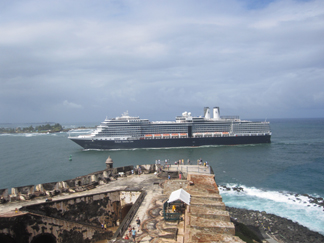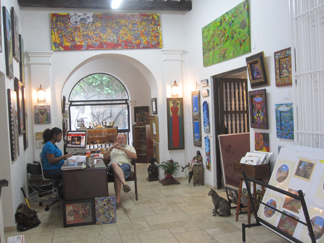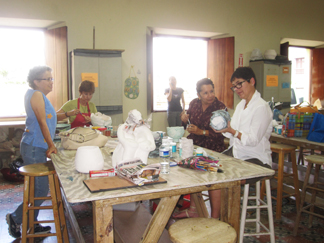Share |
Travel and Culture: Old San Juan Puerto Rico
By Cornelia Seckel
ART TIMES January 2014 online
 (l to r) Myra Schwartz, Cornelia Seckel, Ruth Beyl, Ann Silverman enjoying Sangria at the Hotel El Convento, a former convent now hotel with an excellent restaurant. |
It was The second time I was part of a group of women that went to Puerto Rico as guests of Myra Schwartz who has a condo in Isabela (available to rent at www.Apuertoricoparadise.com. This time before heading to the condo and the beach we explored Old San Juan and made some excellent connections.
Puerto Rico is the easternmost island of the Greater Antilles in the Caribbean Sea, approximately 1,000 miles southeast of Florida and just east of the Dominican Republic and west of the US Virgin Islands. The island is approximately 106 miles wide and 37 miles between the north and south coasts. It is mostly mountainous with large coastal areas in both the north and south regions of the island. The coasts have beautiful beaches with the Atlantic Ocean on the Northern coastline and the Caribbean on the Southern coast. Nearly 4 million people live there, a mixture of the numerous ethnic groups that were brought and settled over the many hundreds of years. Puerto Ricans are known for their warm hospitality, and are very friendly to strangers and it was a pleasure to engage in conversation.
Gathered from a variety of sources: it is believed that the ancient Amerindians first made Puerto Rico their home. The first longstanding peoples to live on Puerto Rico were the Taino Indians, members of the nomadic Arawak peoples of South America who migrated between 1000 - 300 AD from what is now Venezuela. Christopher Columbus visited the island in 1493 but it was Juan Ponce de León who began the actual conquest in 1508, landing at San Juan harbor, which he called Puerto Rico (rich port). A settlement was founded in 1521 on the site of present-day San Juan. As hardship, disease, and Spanish massacres eliminated the Taino Indians, this work force was replaced by African slaves who were introduced in 1513. Arabica beans (coffee) were brought to the island in 1736. While coffee declined, sugar and tobacco grew in importance until the early 1900’s. Today little is grown with 80% of the food imported. Present-day Puerto Rico has become a major tourist destination and a leading pharmaceutical and manufacturing center, as well as a major financial center for the Caribbean. As part of a Spanish reform movement that extended to Puerto Rico, slavery was abolished in 1873, and the new Spanish republican constitution of 1876 granted Puerto Rican representation in Spain's parliament.
  One of the many cruise ships passing by El Morro Fort. on right, restoration project repairing the walls of El Morro Fort |
The Spanish American War of 1898 ended with Puerto Rico ceded to the United States. Puerto Rico remained under direct military rule until 1900. In 1917 the Jones Act stipulated that Puerto Rico was a US territory whose inhabitants were entitled to US citizenship. The act provided for election of both houses of the Puerto Rican legislature, but the governor and other key officials were still to be appointed by the US president, and the governor was empowered to veto any legislation. Politicians hoping to make Puerto Rico the 51st state continue to make their voices heard, as do those seeking complete independence. According to many it seems like the title of commonwealth is a slightly more popular option.
After arriving in San Juan and a dinner of fish, rice and beans we settled into a hotel for the night. The following day we toured old San Juan starting off walking through narrow streets towards El Morro Fort (Castillo San Felipe del Morro), one of the most popular tourist sites with over two million visitors in Puerto Rico. First built in 1539 to protect the city of San Juan from seaborne enemies, Puerto Rico was the gateway to the Caribbean and the first island ships traveling west from Europe would come across that had fresh water. Although its foundation was laid in 1539, the six-level fortification with 18-foot thick outer walls was not considered complete until 1787. It's a World Heritage and National Historic Site, now administered by the U.S. National Park Service.
|
As we walked along the narrow streets of cobblestone that were an iridescent blue/ gray I saw lots of outdoor sculpture, a small market where craftspeople were selling their wares, and of course lots of shops. The architecture was still very Spanish with wrought iron gates and balconies. Puerto Rico is one of the ports for cruise ships and thousands of people embark for a day’s exploring before getting back on their ship.
Returning from the Fort we passed a window that looked into a sculpture studio. Finding the entrance we walked into the Liga Estudiantes de Arte de San Juan. Tatyan Camacho Gautier, one of the administrators, welcomed us to the school and encouraged us to explore the gallery and classrooms. This League of Art Students of San Juan was founded in 1968 and is based on the Art Students League of New York when Betsy Leah Cohen returned to Puerto Rico after studying art at the League in NYC. This atelier-style school, with no grades or certification, began with a handful of students in a small room near their current home. Today there are over 500 students of all ages studying painting, sculpture, drawing, and photography. We met Betsy Pabin, one of the early founders, board member and now instructor in a classroom with her students. It was delightful to see the artwork, the camaraderie amongst the students and Betsy. For more about the school: ligadeartesj.org
 Exodo art gallery in Old San Juan. |
There were several galleries along our path back to the car and I was quite impressed with the work at Exodo Art Gallery and Galeria Cayuca, both showing work of Caribbean artists. The Museum of the Americas has permanent and seasonal exhibitions of the history and culture of the Americas covering art from the pre-Columbian era to the present and showcases a variety of artists from Latin America, the United States and Puerto Rico. It is a museum of ethnography and anthropology. The building in which the Museum is housed was built by the Spanish army in the 1800s and served as a home to some 1000 soldiers and their families until 1898. The building has three floors, each of which has a number of balconies that form galleries around an inner patio. The original rooms served as bedrooms, warehouses, kitchens, jails, stables and dining rooms. During WWII it became a US military hospital and in 1992 the museum was opened. There are numerous other museums to visit including: Museum of Coffee, Tobacco and Rum; Pablo Casals Museum; Museum of Art and History of San Juan; National Gallery; and Children’s Museum. These will have to wait for another time as we spent just one day in San Juan before heading to the beach in Isabela.
Share |


